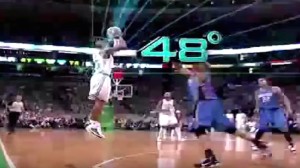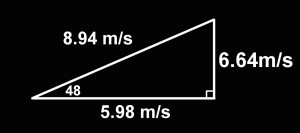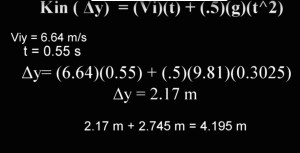As a huge basketball fan, I had always been interested in science behind basketball. Basketball as one of the biggest sports in the world is far more than a simple activity people have fun with and play together, there are also science behind every subtle detail. My last writing was about how a shooting form could influence one’s shot, but I want to discuss more than just the form but the mechanics and the science that lie underneath the process of shooting.
According to Dr. Gintaras Duda, the physics professor at Creighton University, if you would like to shoot a perfect three pointer, the ball must be released at at least 33 degrees from you hand when the ball leaves the basket for a slight chance to hit a shot. However, suppose an individual” shot a ball with an arc of 45 degrees , with the speed of just under 20 miles per hour and two revolutions per second of spin, at 20.9 feet from the basket,” they player would very likely hit a perfect three point shot. Although he does not understand the game well enough, he still gave an incredibly helpful information. In order to make a shot, the arc of releasing a ball must be above 33 degrees. This finding suggests that shooting a good a three pointers had a lot to do with the releasing arc.
, with the speed of just under 20 miles per hour and two revolutions per second of spin, at 20.9 feet from the basket,” they player would very likely hit a perfect three point shot. Although he does not understand the game well enough, he still gave an incredibly helpful information. In order to make a shot, the arc of releasing a ball must be above 33 degrees. This finding suggests that shooting a good a three pointers had a lot to do with the releasing arc.
Speed is also a great factor while shooting the ball. Speed does not only imply how fast the ball goes but also suggest the distance it would travel . Using all time three point shooter Ray Allen as an example, this person explained the physics behind shooting a perfect three pointer like Ray with a series of calculation
. Using all time three point shooter Ray Allen as an example, this person explained the physics behind shooting a perfect three pointer like Ray with a series of calculation . Although this study had seem impractical to apply to reality, it quantified the process and also showed that the highest point Ray Allen’s three point shot reached was 4.195 meters which is 13.76 feet in the air. Therefore further supporting the hypothesis that the arc of releasing a ball is vital to a three point shot.
. Although this study had seem impractical to apply to reality, it quantified the process and also showed that the highest point Ray Allen’s three point shot reached was 4.195 meters which is 13.76 feet in the air. Therefore further supporting the hypothesis that the arc of releasing a ball is vital to a three point shot.
Putting a backspin on a ball while releasing it could also help improve the chance of making a shot. According to the book The physics of Basketball, the author John Fontanella pointed out that the backspin one puts on the ball while releasing it allows the ball to travel the slowest possible speed in the air and a less violent rebound when it hits the board or the rim. This suggest that while taking a shot putting spins on the ball is essential and has greater chance of going in compare to a shot that has no spin at all, also known as the ‘knuckle ball’.
One has to keep in mind while shooting a ball, strength is the most important factor as well. According to Newton’s third law, for every action there is an equal and opposite reaction.  When a player is shooting a ball, he would apply force to the ground and force would apply back to him so he could jump. As him jump, the force that let him jump also apply to the ball therefore allowing him to shoot the ball with that force. In other words, the more force a player puts on the ground, the more force would be apply to the ball. Therefore, in order to shoot a ball well and consistent, lower body power matters as much as the upper body. The stronger you are, the more likely you are able to send the ball in a higher point and faster speed, therefore could help improve the accuracy of the shot.
When a player is shooting a ball, he would apply force to the ground and force would apply back to him so he could jump. As him jump, the force that let him jump also apply to the ball therefore allowing him to shoot the ball with that force. In other words, the more force a player puts on the ground, the more force would be apply to the ball. Therefore, in order to shoot a ball well and consistent, lower body power matters as much as the upper body. The stronger you are, the more likely you are able to send the ball in a higher point and faster speed, therefore could help improve the accuracy of the shot.
In sum, shooting a ball well in basketball is not as simple as it looks on TV, it requires loads of practices to help one’s muscle adjusting to a certain extent so that they could knock down shots after shots. Science also helps basketball training easier since it could help people to understand the game better.

First off, I am also a die-hard basketball fan and this past summer I purchased “The Book of Basketball” by Bill Simmons. It was an awesome book and even though it’s 700 pages it never gets old. I recommend the heck out of this book. Anyway, I found this topic quite interesting for reasons beyond my love for the game. With the sports science revolution hitting the NFL, it seemed destine for some scientific practices to translate to the game of basketball. It has seemed as though in the past couple of years in the NBA that shooting, and 3-point shooting in-particular, are becoming more important than ever. 3-point shots are more important than shots taken in the paint, as referenced here http://www.sbnation.com/2012/9/3/3288584/nba-shooting-range-three-pointers-hook. The only problem I have with people saying shooting is becoming more of a science is the fact that anyone can release the ball at a perfect spot and speed when they are shooting away in a gym. But when it comes to a live game and that defenders in your face it comes down to your instinct, knowing if he/she is going to block it and how high you should jump to incorporate strength in your shot. In the end though, I agree the science behind the game is starting to evolve the league.
I am a huge basketball fan as well, so this article definitely attracted my attention. It’s astounding that scientists are able to pinpoint, in numbers, what a good shooting form is. There are so many players in the NBA with smooth looking jumpers like Curry, Klay Thompson, Kyle Korver. I bet they nail every point of criteria in this article. This could be useful for when I play basketball, as I am a horrendous shooter. When I was reading this article, I kept on thinking of exceptions. The only guy I could think of was Shawn Marion in his prime who had an ugly jump shot back in his Phoenix Suns days. But they still went in. I think a lot of memory must come with perfecting a jumper, finding that consistent sweet spot when releasing the ball every time one shoots.